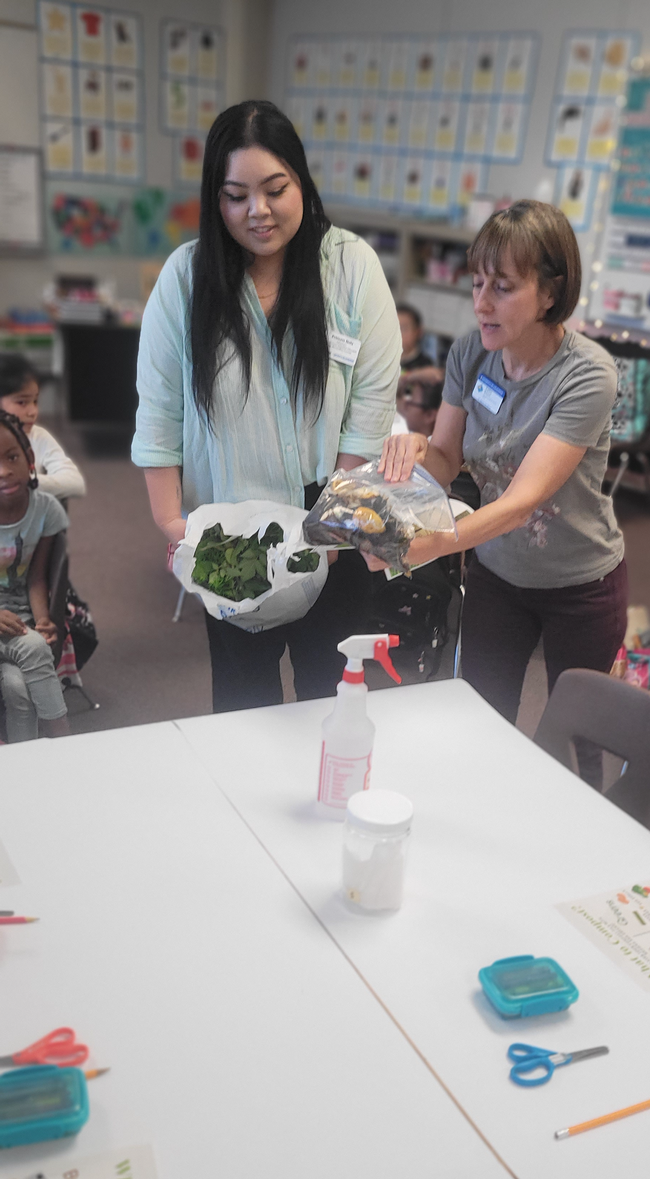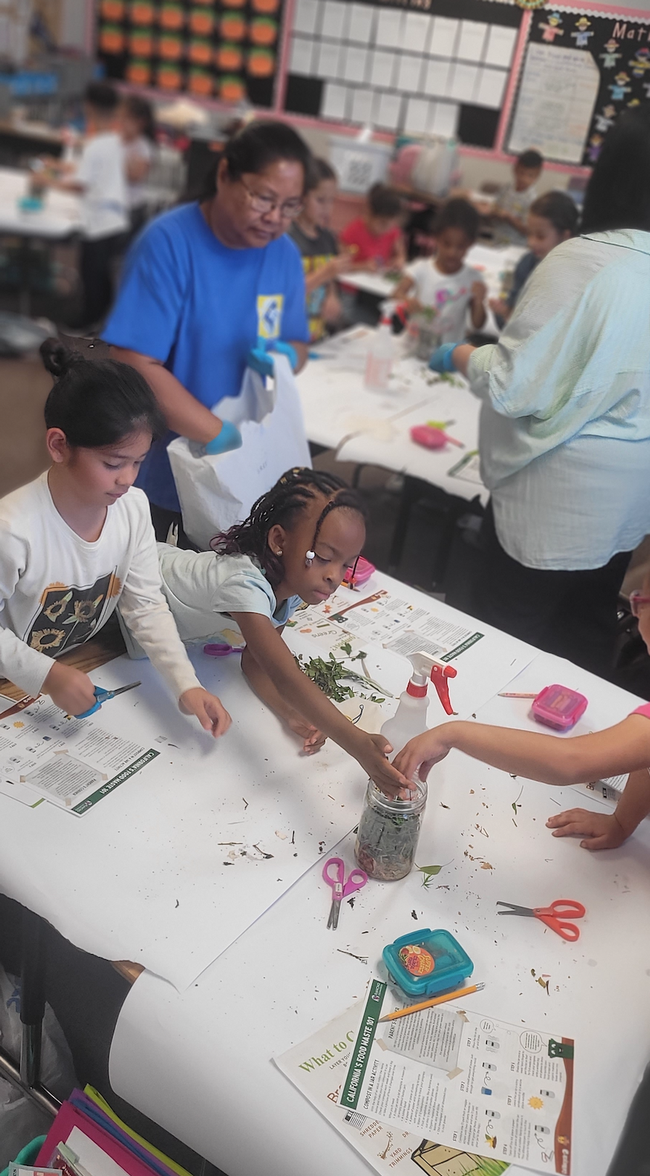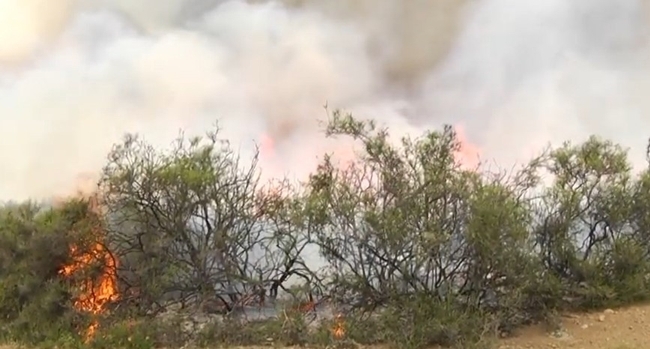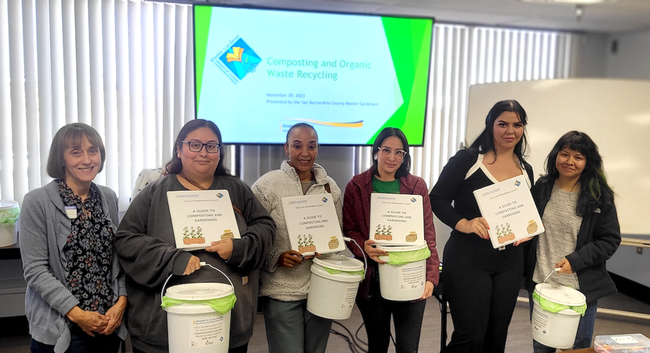- (Public Value) UCANR: Promoting healthy people and communities
- Author: DIANA CERVANTES
A menudo subestimamos el impacto del humo de los incendios forestales, pero su efecto en la salud pública es significativo y creciente, especialmente en California. A continuación, te ofrecemos una guía rápida para protegerte a ti y a tu familia del humo de estos incendios.
La División de Agricultura y Recursos Naturales de la Universidad de California (UC ANR) ha producido una serie de videos e información relevante sobre los incendios y los efectos dañinos del humo. ¿Sabías que el humo de los incendios forestales es una mezcla compleja de compuestos químicos, como dióxido de carbono, vapor de agua y partículas finas, conocidas como PM2.5? Estas partículas pueden penetrar profundamente en los pulmones y causar problemas de salud graves. La exposición al humo de los incendios forestales está en aumento, por lo que es crucial estar preparado para protegerte y proteger a tu familia.
¿Qué es la Calidad del Aire?
La calidad del aire se refiere a la cantidad de contaminantes presentes en el aire que respiramos. Durante los incendios forestales, esta calidad puede deteriorarse rápidamente debido al aumento de partículas finas (PM2.5) y otros compuestos químicos en el humo. Comprender cómo se mide la calidad del aire y qué significan esos valores es fundamental para tomar medidas efectivas y salvaguardar nuestra salud.
Recomendaciones del Centro para el Control de Enfermedades (CDC)
El CDC aconseja a las personas con problemas pulmonares o cardíacos que tomen medidas adicionales, ya que son los grupos más vulnerables a los efectos del humo.
Medidas para mantener la calidad del aire
Las quemas prescritas son una herramienta importante para manejar los riesgos de incendios forestales y minimizar su impacto en la calidad del aire. Estas quemas controladas se realizan bajo condiciones específicas, ayudando a prevenir incendios forestales extremos y reduciendo así la cantidad de humo producido.
Consejos prácticos para protegerse del humo:
- Permanece en interiores: Mantén las ventanas y puertas cerradas para evitar que el humo entre en tu hogar.
- Usa purificadores de aire: Los purificadores de aire con filtros HEPA pueden ayudar a reducir la cantidad de partículas finas en el aire interior.
- Usa mascarillas adecuadas: Si necesitas salir, usa una mascarilla N95 que se ajuste bien para filtrar las partículas finas.
Monitoreo de la calidad del aire:
- Utiliza aplicaciones y sitios web como AirNow y PurpleAir para monitorear la calidad del aire en tiempo real y ajustar tus actividades según sea necesario.
Efectos Inmediatos en la Salud:
- Tos
- Dificultad para respirar normalmente
- Ardor en los ojos
- Irritación en la garganta
- Moqueo
- Irritación de los senos paranasales
- Sibilancias y dificultad para respirar
- Dolor de pecho
- Dolores de cabeza
- Ataques de asma
- Cansancio
- Latidos cardíacos acelerados
Posibles efectos a largo plazo:
La exposición repetida al humo de los incendios forestales puede tener efectos a largo plazo en la salud, como el desarrollo de enfermedades respiratorias crónicas, problemas cardiovasculares y una mayor susceptibilidad a infecciones respiratorias.
Recursos adicionales:
- Author: Linda J Forbes
Entre agosto del 2023 y marzo del 2024, residentes de recursos limitados de diversos orígenes étnicos del condado de San Bernardino participaron en clases interactivas en las que expertos de Extensión Cooperativa de la Universidad de California les enseñaron sobre seguridad alimentaria, a reducir el desperdicio de comida y producir sus propios alimentos.
Las clases, son parte de un proyecto que se lleva a cabo en el condado de San Bernardino dirigido por Christine Davidson de UCCE y el Programa Ampliado de Educación sobre Alimentos y Nutrición (EFNEP, por sus siglas en inglés) que movilizó a un equipo de voluntarios de este último programa y de Maestro de Jardineros y Maestros Conservadores de Alimentos de UC para educar a familias en comunidades en desventaja a través de una serie de talleres prácticos.

Estos esfuerzos fueron financiados por el Programa de Pequeños Subsidios del Programa de Investigación y Educaciónen Agricultura Sustentable de UC, el cual apoya la creación de sistemas alimentarios sustentables en las comunidades.
Las participantes también asistieron a talleres del Programa Maestro de Jardineros para aprender a cultivar verduras en sus huertos familiares y preparar abono o composta con desperdicios de comida. El Programa Maestros Conservadores de Alimentos de UC también dijo presente en este proyecto enseñando a los participantes a preparar recetas saludables y preservar alimentos de manera segura con un enfoque en reducir el desperdicio de comida.
Por otro lado, 220 niños pertenecientes a dos escuelas asistieron a la serie de lecciones de EFNEP y un taller donde aprendieron a hacer composta con gusanos o en un frasco. “A los estudiantes le encantan las actividades prácticas y con estos conocimientos pueden participar en la producción de abono con desperdicios de comida en casa”, manifestó Davidson. “Fue especialmente satisfactorio enseñarles a los estudiantes de kinder sobre compostaje pues fue un concepto nuevo para ellos”.
El subsidio de SAREP aportó fondos para la compra de material y los kits o paquetes que padres y niños se llevaron a casa para aplicar sus nuevos conocimientos en la preparación de diferentes ensaladas y consomé de sobras de verduras, para cultivar huertos de hierbas y hacer composta en casa. Los kits son un excelente incentivo para que las personas asistan 
Con una mejor planeación de comidas y el almacenamiento apropiado de alimentos, las familias pueden ahorrar comida y dinero. “Yo he empezado a guardar las sobras para preparar un consomé de verduras que uso para cocinar arroz. A mis hijos le encanta colectar las sobras y eso ahorra dinero al comprar el consomé”, dijo uno de los padres de la primaria Bradley de San Bernardino.
Además, a las familias se les educa sobre la reducción de desperdicios orgánicos requerida por el Proyecto de Ley del Senado 1383 y lo que pueden hacer para reducir el desperdicio de comida.
El producto final del proyecto financiado por SAREP será el Kit de Herramientas para el Taller para Prevenir el Desperdicio de Alimentos en español e inglés que será compartido ampliamente y entregado en los talleres de UC ANR por el personal y voluntarios en otros condados. “Nuestro objetivo más allá de proporcionar estos materiales para apoyar a nuestra comunidad es ayudar a incrementar su uso en todo UC ANR para que más familias puedan beneficiarse de ellos”, mencionó Davidson.
Subsidios pequeños, un gran impacto
Entre las prioridades de financiación del Programa de Pequeños Subsidios se incluyen a granjeros, rancheros y administradores de tierras en la adopción de prácticas regenerativas del medioambiente y asociarse con comunidades rurales, urbanas y tribales para expandir el acceso a alimentos producidos de manera saludable, sustentable y promover el bienestar de la comunidad.
“El Programa de Pequeños Subsidios es una parte importante de nuestra misión”, indicó Ruth Dahlquist-Willard, directora interina de UC SAREP, un programa de la División de Agricultura y Recursos Naturales de UC. “Los resultados del programa muestran que una pequeña inversión financiera puede tener un impacto grande en el mejoramiento de las vidas de los californianos”.
Este artículo es parte de una serie acerca del impacto del Programa de Pequeños Subsidios de UC SAREP. Para apoyar este programa, por favor haga sus donativos aquí. Elija el Programa de Pequeños Subsidios de SAREP para que sea asignado a este programa.
Adaptado al español por Leticia Irigoyen del artículo en inglés. Editado para su publicación por Diana Cervantes
- Author: Michael Hsu
New Cooperative Extension director has worked extensively with Native American communities, youth groups
Growing up in Upper Lake, along the “North Shore” of Clear Lake, Matthew Barnes lived near several of the Lake County region's seven federally recognized tribes. Although he counted several Native Americans among his diverse circle of childhood friends, and was very familiar with those communities, Barnes was nonetheless quite nervous when he was appointed in 2009 as the inaugural executive director of the Boys & Girls Club of the Pomo Nation.
Barnes – a non-Native of European and Filipino descent – vividly remembers the tribal administrator paying him a visit on one of his first days on the job. “He said, ‘Hey, you have two ears and one mouth, so listen twice as much as you speak and you'll be fine,'” Barnes recalled. “And that's definitely stuck with me.”
That approach is continuing to guide Barnes in his new role as University of California Cooperative Extension director for Lake and Mendocino counties. He will guide and support research, outreach and education activities to meet the area's agriculture, natural resources, and youth and community development needs.
Since starting in May, Barnes has been getting a crash course from UCCE advisors and staff on viticulture research, pest management practices, 4-H camps, and a host of other projects and programs – while also meeting with local communities on the region's most pressing challenges.
“What I've been doing – and will continue to do – is just to listen and learn, and when I can add value to a conversation or project, then I'll do that,” Barnes said. “But leadership to me starts with the relationships we build – with our staff and with the community.”
Bringing a range of experiences in youth programs, social services
One area in which Barnes will certainly add value is developing youth and community programs. During his time with Boys & Girls Club of the Pomo Nation, it was one of only three Boys & Girls Clubs established on tribal land in California. In that role, Barnes faced the unique challenge of integrating the Boys & Girls Club curriculum into a community for which it was not originally designed.
By adapting the curriculum to include culturally relevant topics, Barnes transformed the program into a model that eventually aided in the creation of a Native American-focused branch, Boys & Girls Clubs of America Native Services.
“This initiative now serves as a national standard for Boys & Girls Clubs on tribal lands,” Barnes said.
He later became a director of California Tribal TANF (Temporary Assistance for Needy Families), a direct cash assistance and supportive services program for Native American families in 17 counties across the state.
During his decade of TANF work, Barnes launched career development programs, alcohol and other drug counseling programs, and cultural revitalization initiatives. Some of the programs are still running and serving communities to this day.
“The trick is making those programs something that participants can see the value in,” Barnes explained. “And to do that, you go into the communities and talk to people and listen to what they need – instead of you telling them what they need.”
Barnes' experience partnering with Native American communities is just one of the many strengths he will bring to UCCE and UC Agriculture and Natural Resources.
“We're very excited to have Matthew join the UC ANR family,” said Lynn Schmitt-McQuitty, UC ANR's director of County Cooperative Extension. “His personal knowledge of Lake and Mendocino counties and his previous work with Indigenous populations will be a tremendous asset to extending and elevating our work.”
Immediately prior to joining UC ANR, Barnes served as director of Lake County's Upward Bound program, which helps students from three local high schools experience and prepare for higher education.
“Overall, what drives me personally is the opportunity to make an impact on communities, on youth, and on people in general through program development and management,” Barnes said.
Inspiring young people as a mentor
Barnes' passion for youth development – and the impetus for his bachelor's degree in social work from Cal Poly Humboldt – can be traced to his AmeriCorps experience while he was attending Mendocino College. For two years, he worked as a tutor for young people, in Lake County and then in Sonoma County, and saw firsthand the difference educators and mentors can make in their lives.
“You could say I kind of caught the bug – just seeing the light bulbs go on when you're helping a youth of that age,” Barnes said.
From there, Barnes took a position directing teen programs for the Boys and Girls Club of Healdsburg, where he began to fully appreciate the importance of trusted adults simply “being there” for young people as a listening ear for whatever they want to talk about.
Among the many teens Barnes worked with, “Rodrigo” was a middle schooler who was pegged by his school and community as someone who could “slip through the cracks.” Rodrigo was the last to go home at the end of each day, and Barnes would chat with him – answering his questions about life or just talking about a new rap album.
“I realized I was ‘that person' for him – that person outside his house, outside his school,” Barnes said.
Even after Barnes left the Boys and Girls Club, Rodrigo – bound for university – invited him to his high school graduation. Barnes said it is tremendously gratifying to know he had a “small role” in shaping the path for Rodrigo – and countless others.
“Their success is still theirs; it's not necessarily because of me,” Barnes added. “My job is to do what I can in the moment to hopefully plant some seeds that may sprout in the future.”
Settled in Middletown, not far from his hometown, where he and his wife are raising two children, Barnes is now positioned to help nurture a flourishing Lake County and resilient Mendocino County.
“I feel like my past experiences, both in life and my career, have prepared me for this,” Barnes said.
- Author: National Pesticide Information Center (NPIC)
Acetic acid, also known as vinegar, is used in products for weed control. Many people choose it because it is natural. However, acetic acid can damage skin and eyes, especially at concentrations commonly found in weed killers.
What is the difference between acetic acid, vinegar, and horticultural vinegar?
You may know acetic acid best as vinegar. Vinegar is a solution of acetic acid in water. Acetic acid is a naturally occurring substance that is found in all living things. It is formed during fermentation. Acetic acid can also be made industrially. It is used in many industrial processes, including the manufacture of dyes, plastics, some drugs, and other industrial chemicals. It is also used in textile printing.
Household vinegar such as distilled white vinegar used for cleaning or cooking generally contains 4-6% acetic acid, which is diluted in water. Higher strength acetic acid solutions are sold for other purposes. Horticultural vinegar typically refers to a concentrated solution of 20% or more acetic acid. It is sold to kill weeds. You may find even higher concentrations of acetic acid sold in stores or online.
Are there health risks of using vinegar/acetic acid?
Acetic acid is irritating to the eyes and skin. At concentrations above those usually found in household vinegar, it can be extremely irritating or corrosive. Acetic acid can permanently damage the corneas if it gets into your eyes. It can burn skin and the tissues of your mouth and throat if you accidentally swallow it. People have had irritation in their nose, throat, and in their lungs if they breathed in enough of the vapor.
Never leave any pesticide unattended around children or pets. Never leave any pesticide in an unlabeled container. "Natural" does not mean "safe!" Remember, the dose makes the poison. The higher the concentration of acetic acid, the greater the risk.
How does vinegar/acetic acid kill weeds?
Acetic acid is a non-selective contact herbicide. It must touch the foliage of the plant in order to work. It does not damage tissue it does not touch. It does not travel throughout the plant. Acetic acid breaks open cell walls and causes cell death. The plants die by drying out.
Acetic acid breaks down rapidly in the environment. It does not leave a residue.
Acetic acid readily turns into a vapor. Like other chemicals, warmer temperatures increase volatilization, or turning into a vapor. The vapor can irritate the nose, throat, and lungs if breathed in. Prolonged exposure to high concentrations of the vapor can cause fluid buildup in the lungs.
What sort of pesticide/herbicide products contain vinegar/acetic acid?
Products containing vinegar/acetic acid that have been registered by the United States Environmental Protection Agency (U.S. EPA) as pesticides/herbicides will have a signal word and an EPA registration number on their packaging. Label information includes where and how to use the product, what precautions to take, personal protective gear to wear while using the product, and first aid instructions in case something goes wrong.
Products registered to be used as herbicides have high concentrations of acetic acid, typically 20% or more. All registered herbicides containing acetic acid have a signal word of DANGER because of the high concentrations and high toxicity. Specifically, it is because of the risks of the acid to the eyes and skin. Low concentrations of acetic acid are used in insect lures.
Acetic acid is available commercially for many purposes. Consider purchasing a product registered as a pesticide if you plan to use acetic acid for weed control. Doing so means you will have directions for use as an herbicide and information on precautions you can take to keep risks low. Products that do not have an EPA registration number and signal word are not registered to be used as herbicides and may not have appropriate safety or precautionary information for that use. Look for an EPA Registration Number and a signal word to ensure you are purchasing a registered product.
How can I reduce the risks when using vinegar/acetic acid?
- Any time you use a pesticide, always read and follow all label instructions. The label is the law.
- If the label specifies personal protective equipment, you must use that equipment.
- Wear long sleeves, long pants, shoes, socks, and gloves at a minimum whenever using any pesticide.
- Consider wearing protective eye wear and chemical resistant gloves when mixing, diluting, or applying vinegar as an herbicide because of its acidic and corrosive nature. The label instructions may require their use.
- Keep everyone else away from the treatment area until dry.
- Keep all pesticides away from children and pets. Remember that horticultural vinegar can badly damage your eyes or blind you!
- Consider integrated pest management strategies that do not use chemicals to control weeds.
For more information about pesticides and pesticide safety, visit the National Pesticide Information Center (NPIC) website at npic.orst.edu.
[Originally featured in the Summer 2024 edition of the Home and Garden Pest Newsletter]
- Author: Marianne Bird
4-H volunteers can sometimes feel discouraged as they struggle to find help in their clubs or projects. At the root of their disheartened spirit is sensing they are alone in doing a big job. This may lead to feeling unappreciated and, most certainly, tired. Where is help when you need it?
Everyone is busy these days, and time is a treasured and protected commodity. Yet in my years of collaborating with volunteers I've found most people are willing to help if they know what needs to be done, if they feel that they can do it, and if they are asked. Those successful in recruiting adults recognize that they are not simply asking for assistance, they are offering opportunity: an opportunity to connect, to share, to be appreciated. Here are some pointers to foster involvement.
Know what you need: Be specific and clear about the job to be done so people know what is expected and can better judge if it's something they can help with. If you need a driver for a field trip next Saturday from 1:00 to 4:00, say so. For larger jobs, create a brief description outlining the tasks to be done, the skills required, and the approximate time it will take. The more specific you are in describing the job, the better equipped you are to recruit.
Build a sense of community in your group: Our most successful clubs and projects enjoy a sense of connection. Learn about the adults in your group—their interests, time constraints, skills and what they enjoy. Not everyone can give the same thing, and knowing folks makes it easier to ask them to volunteer. It also makes it easier for them to accept the invitation to help.
Identify who would be best for the task: It's easy to fall into the “warm body syndrome,” the “we need someone so anyone will do” mindset. The job you are recruiting for is an important one and shouldn't be filled by just anybody. For one thing, they may not be happy in it. For another, they may not do such a good job (and that will mean even more work for you). Inventory what qualities you're looking for in the person you seek. When recruiting an enrollment coordinator, do they need computer skills? Availability at club meetings? Accessibility by phone? Someone detailed oriented with good follow through? Then seek someone who fits the bill!
Ask: This doesn't mean standing in front of the group and saying, “We need someone to coordinate our club service project. Please see me afterward if you're interested.” Once you have identified who would be best in the job, speak to them personally. Tell them what you're seeking, and why you're asking them. They need to know the reason you think they're the right person to fill the role. Then give them time to consider.
Remember to thank: This goes without saying and is easy to do with notes and calls and public acknowledgement.
Making a good match with volunteers and the tasks at hand is the key to finding the help you need. Fitting the right person in the job means the work will be done well and those helping will feel a sense of fulfillment.







